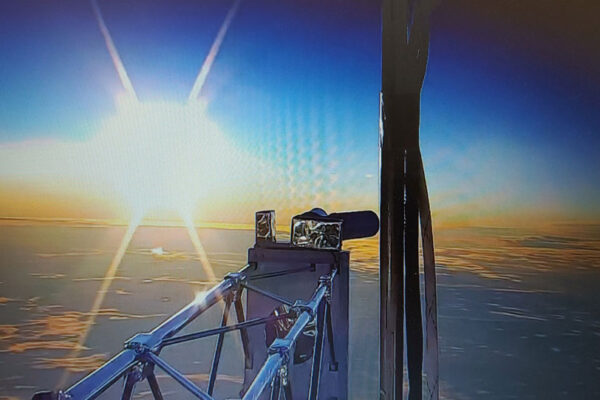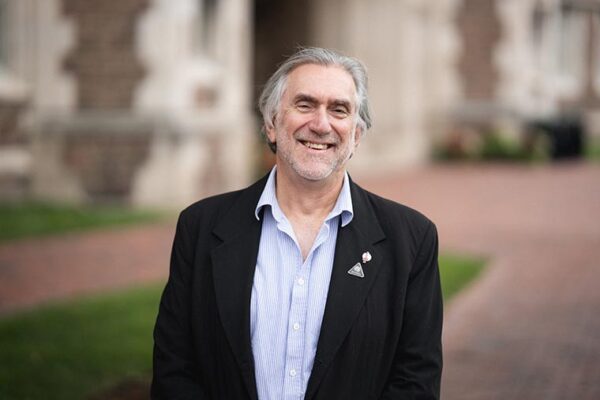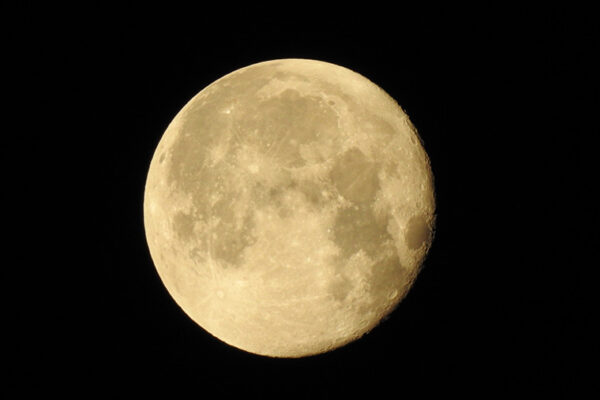It can be hard to find a nice, dark place to look up.
Amateur astronomers and professionals alike are discovering that it is increasingly difficult to find night sky viewing areas. According to a recent study, 80% of Americans and one-third of the planet’s population can no longer see the Milky Way from their homes because of light pollution.
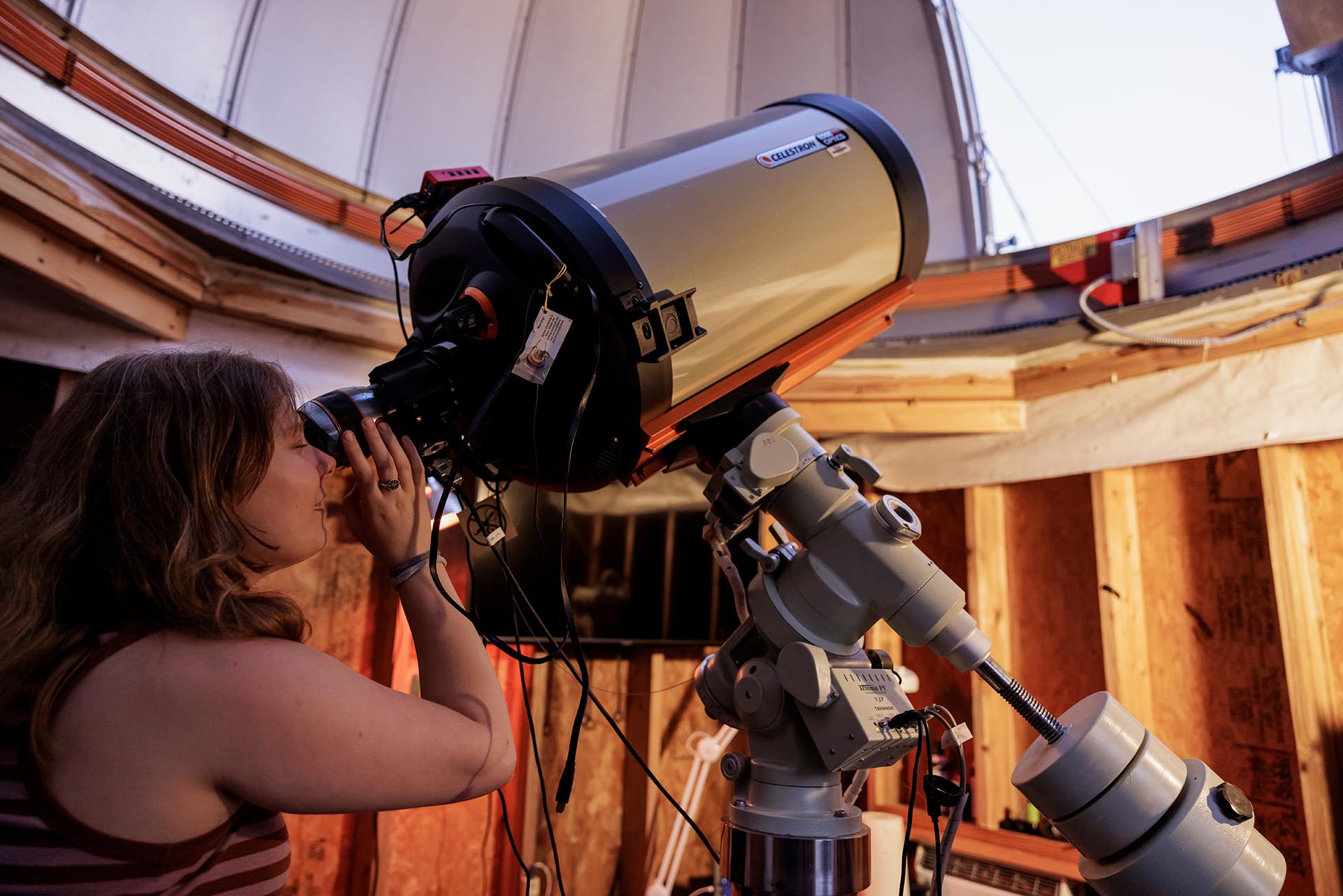
Students working at Tyson Research Center over the summer learned about the night sky at the observatory from faculty members in the departments of Earth, Environmental and Planetary Sciences and of Physics.
That’s part of why Jim Buckley, a professor of physics in Arts & Sciences, was excited to build an observatory at Tyson Research Center, the environmental field station of Washington University in St. Louis.
Though hardly remote — Tyson is located only about 20 miles outside of the city of St. Louis — the observatory offers local users a one-of-a-kind stargazing experience.
On a recent night, a group of enthusiastic student scientists with Tyson’s summer research program crowded around Buckley as he lined up the 14-inch Celestron optical-tube telescope to take a closer look at Mars.
Viewing the red planet was Buckley’s backup plan. Smoke from wildfires burning in Canada cast a haze that obscured the astronomical event he had intended to share with the students, a bright supernova blaze alight in the Pinwheel Galaxy.
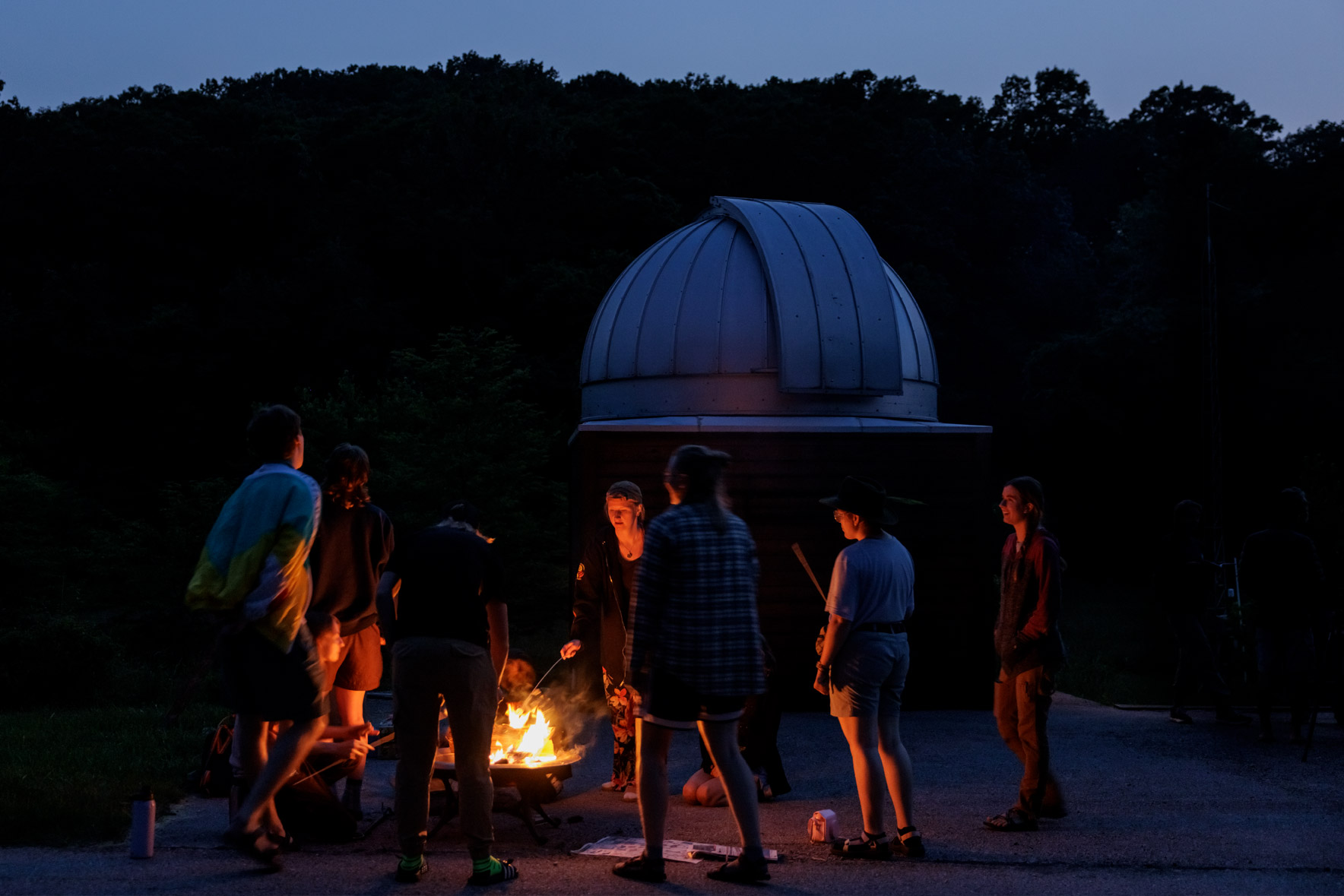
Students working at Tyson Research Center over the summer learn from faculty members about the night sky.
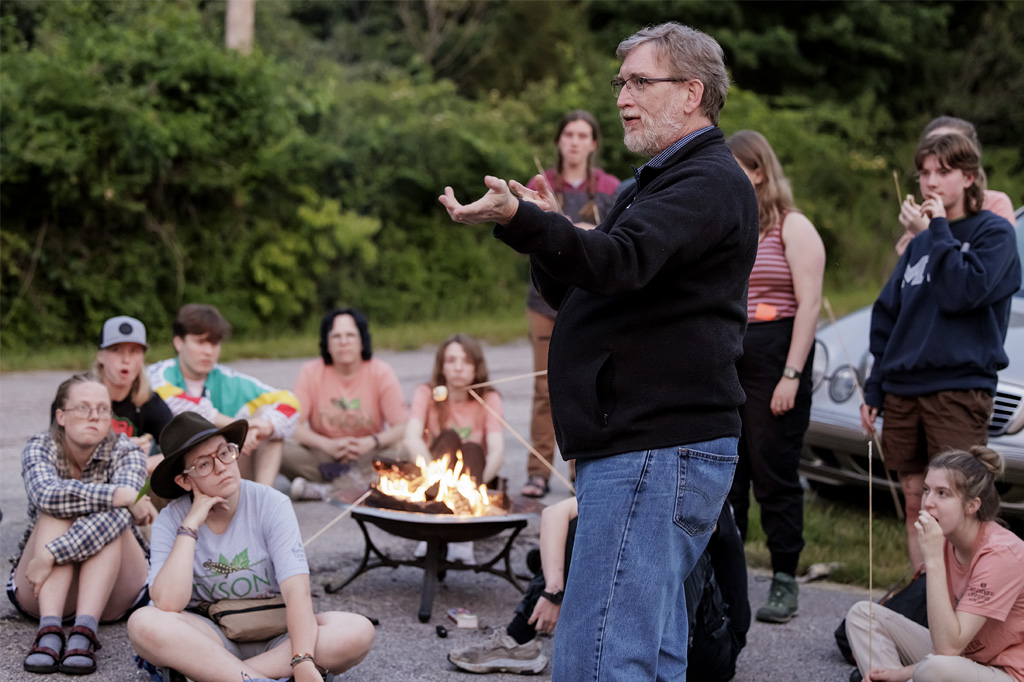
Buckley shares his knowledge at the observatory.
“It’s a thrill to see a supernova that has just gone off in another galaxy,” Buckley said.
The telescope is powerful enough for viewers to see the action in a spiral galaxy 21 million light-years away from Earth. Or to marvel at details of our closest neighbors in space, like the dark areas of mare — the false “seas” on the surface of the moon and Mars. Such wonders are available to the curious few who find their own bit of darkness.
New eye on the sky
Buckley and colleagues — including Manel Errando, an assistant professor of physics, and Mike Krawczynski, an associate professor of earth, environmental and planetary sciences — recently upgraded the Tyson observatory, rebuilding the base with a new wood frame and adding a professionally designed steel dome.
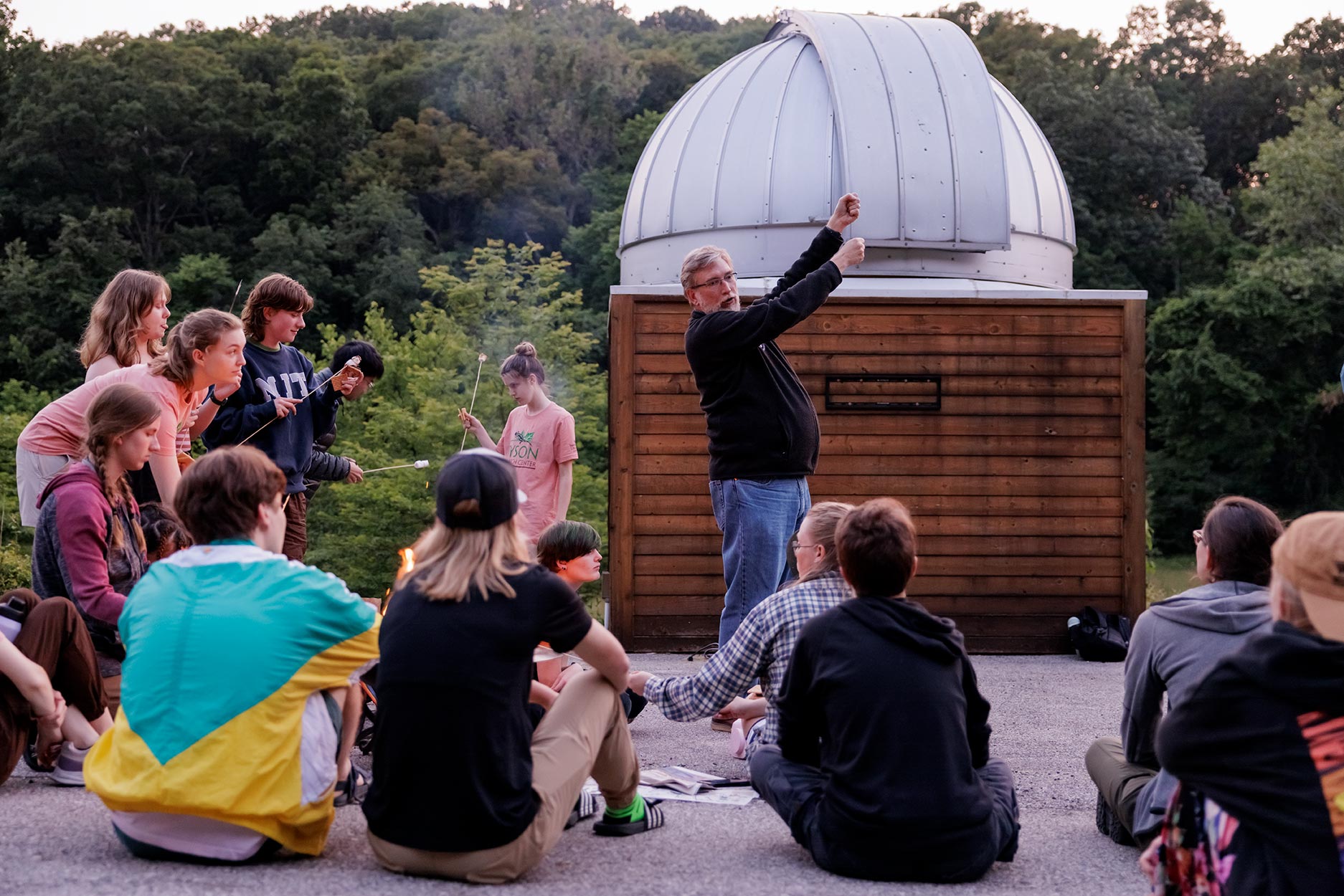
Students gathered around a fire pit in front of the Tyson observatory to listen to Buckley and await the sunset.
Researchers with the university’s McDonnell Center for the Space Sciences have made astronomical observations and hosted many outreach events at the observatory over its 20-plus years in operation. Still, the Tyson observatory is relatively unknown outside of St. Louis astronomy circles.
More familiar to many is the iconic Crow Observatory, the stately white dome perched on top of the physics building on the Danforth Campus. Students still use that classic observatory, built more than a century ago, for physics and astronomy-related classes. On weekday nights during the regular school year, members of the public can visit, too.
In fact, WashU maintains two out of the six observatories in the St. Louis area. But city lights have made it more and more difficult to observe certain astronomical events from the hilltop campus.
Soon after Buckley started working at WashU in 1997, he learned that the university owned about 2,000 acres of forest that was home to the university’s environmental field station. Even better, Tyson was essentially surrounded by another 4,000 acres of land that had been set aside for conservation, including Castlewood State Park to the north and Route 66 State Park to the west.
It seemed like the perfect spot for a new eye on the night sky. Few roads. Fewer buildings or streetlamps. No neon signs or headlights from passing cars.
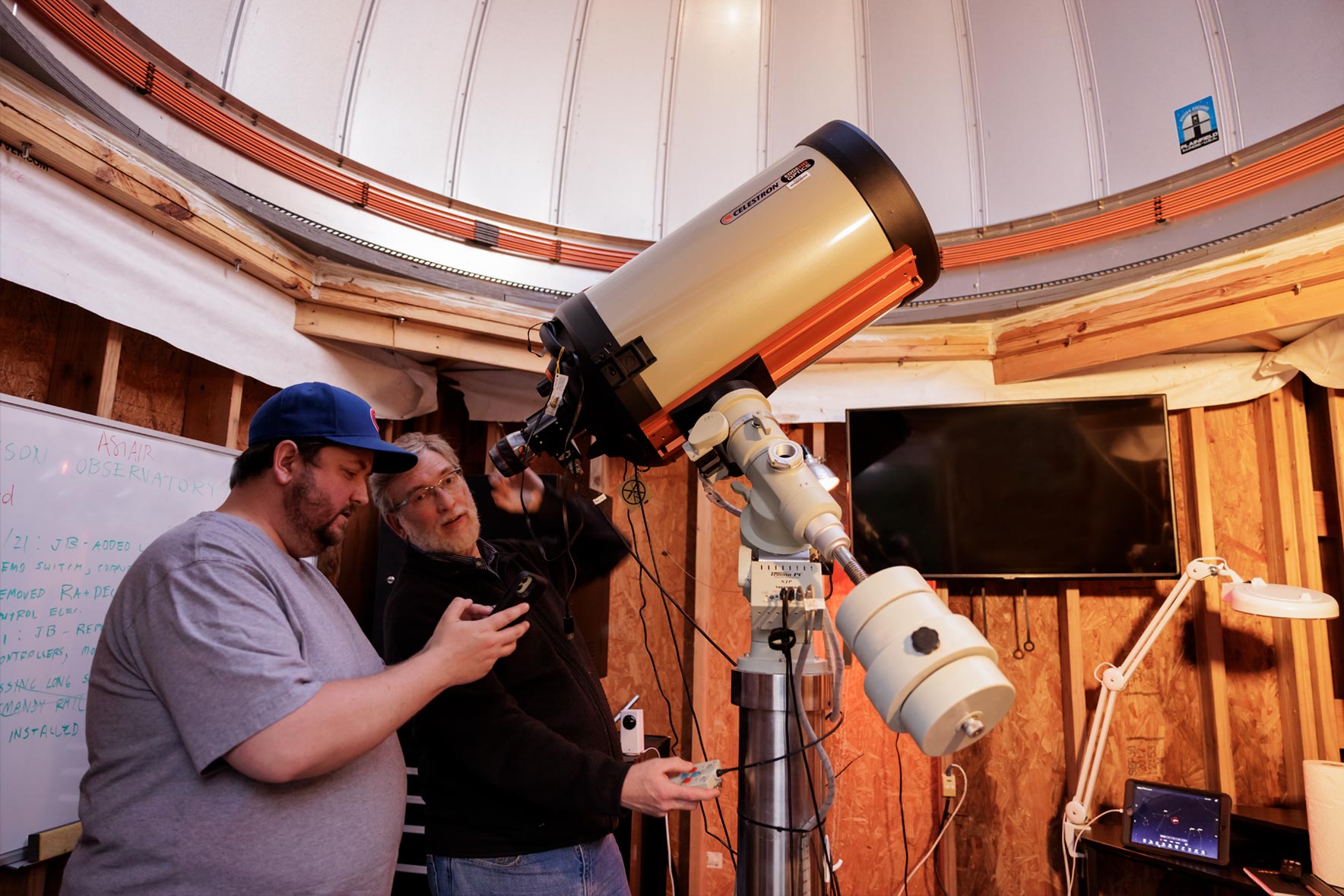
Buckley (at right) adjusts a telescope while Krawczynski checks a night sky app on his phone.
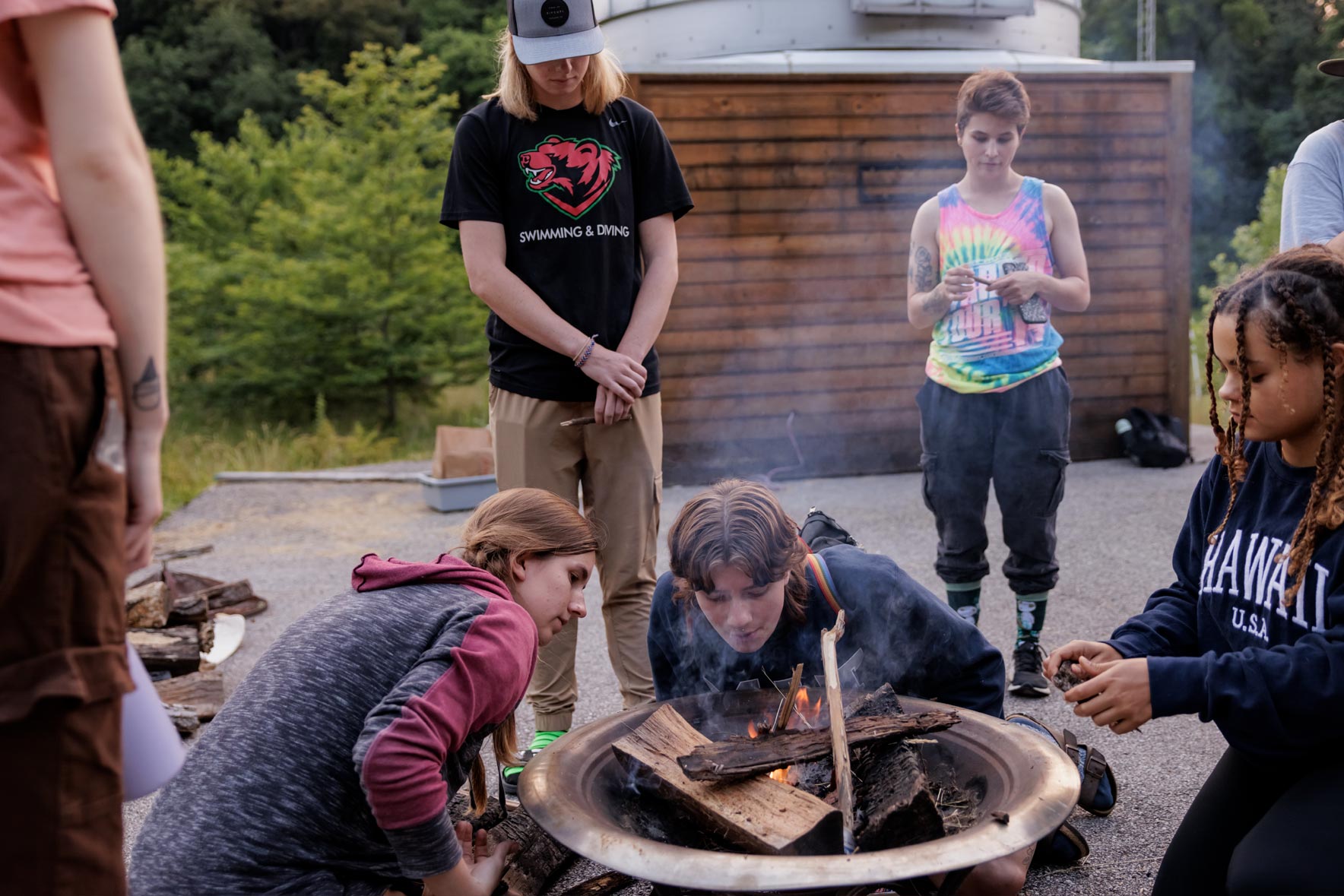
Students build a fire while awaiting their night sky viewing.
Building the Tyson observatory as a dark sky alternative to city observatories was easier said than done. Buckley consulted with the Tyson Research Center administration team to choose a location near what was known as the “New Pond Site,” in a clearing at some distance from trees. Buckley then worked with physics department colleagues to pour the foundation and install a fiberglass dome. He chose the scope and a durable mount for the new observatory.
But after it was built, it soon was clear that the dome would be difficult to maintain. Internal equipment was exposed to the elements and became harder to use. And then there were the critters.
“We fought a constant battle cleaning up mouse droppings, black widow spiders, mud dauber nests and millions of ladybug carcasses that jammed essentially every warm electronics enclosure or moving part,” Buckley said.
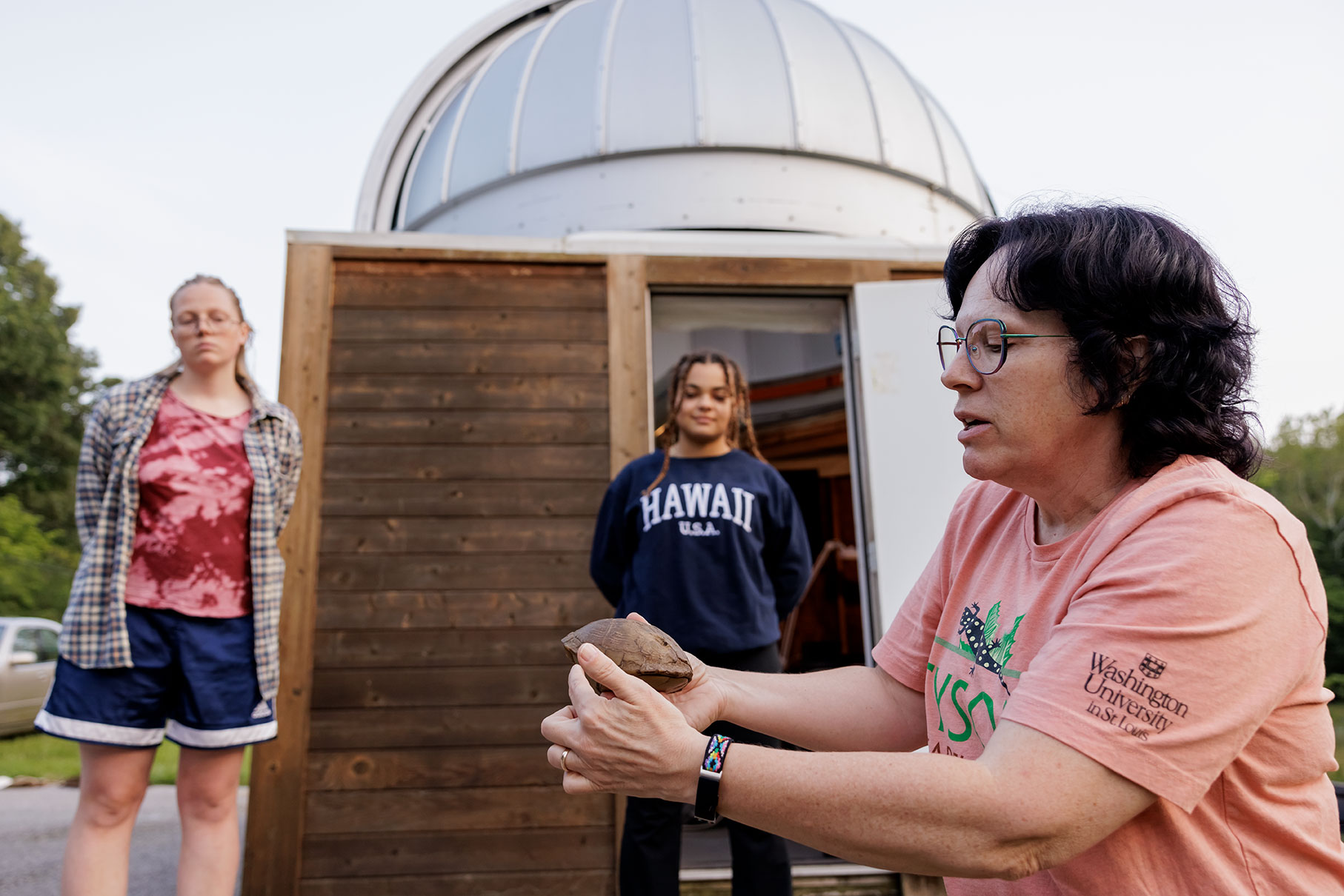
Susan Flowers, front right, holds a box turtle found in the grass on the ground outside of the observatory. Tyson Research Center is home to many native Missouri animals and insects, some of which have tried to take shelter in the observatory over the years.
In 2015, the M.R. Metzger Family Foundation provided a gift to the Department of Physics that included support for observatories. In consultation with Martin Israel, then-director of the Crow Observatory and now a professor emeritus of physics, the department decided to use the funds to upgrade the Tyson observatory. With help from many hands — including machine and electrical work completed by Denny Huelsman and Kenny Schmidt from the physics machine shop, and lots of support from Tyson maintenance crew workers Pete Jamerson, Tim Derton and Dan Walton — researchers took their first new images of the moon in December 2021.
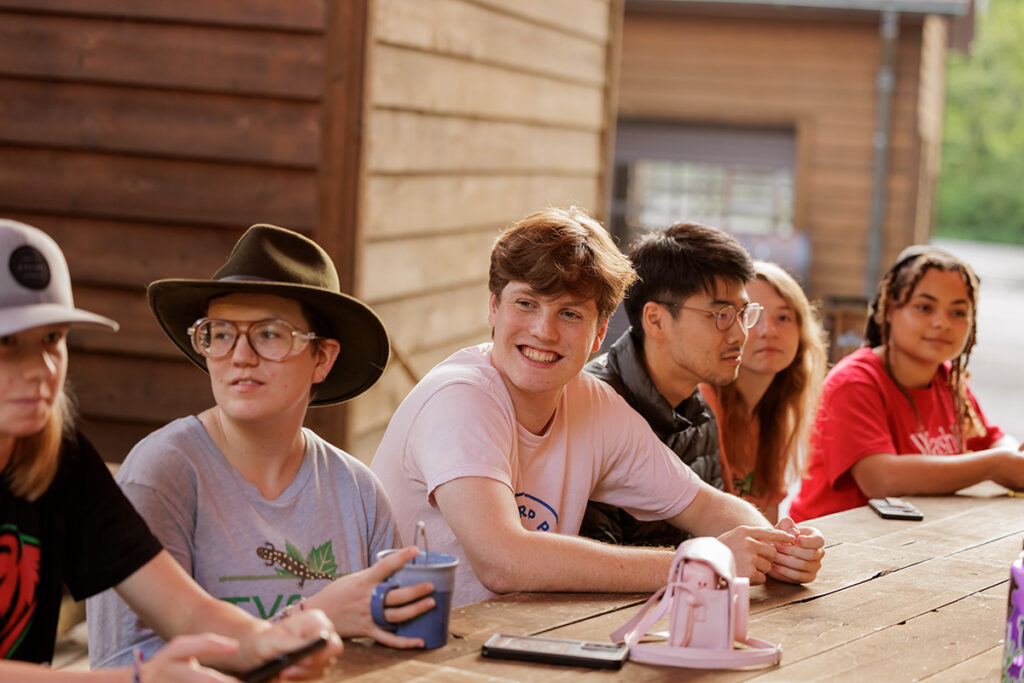
Buckley and Errando are now making plans to incorporate observations at the Tyson observatory in the Washington University undergraduate curriculum.
Working with student researchers, Buckley developed and installed an imaging polarimeter for the Tyson observatory telescope. In the future, he and Errando envision opportunities for students to process images and photometry data obtained at the Tyson observatory, as well as a more formal schedule for observatory visits.
Location, location, location
The St. Louis area has one major planetarium and several small observatories that have viewing events open to the public, according to the St. Louis Astronomical Society.
Some of these observatories have similar telescopes as the one now at the Tyson observatory, notably the observatory maintained by the University of Missouri-St. Louis, but the site at Tyson is definitely darker, Buckley said.
“I think the Tyson location is really the big difference. It is great that Washington University has access to this area — it is relatively close to campus but beyond direct city lights,” he said. “To be honest, it’s much less impressive than the observatories at many universities, but for a big city, it’s about as good as you can do,” he said.
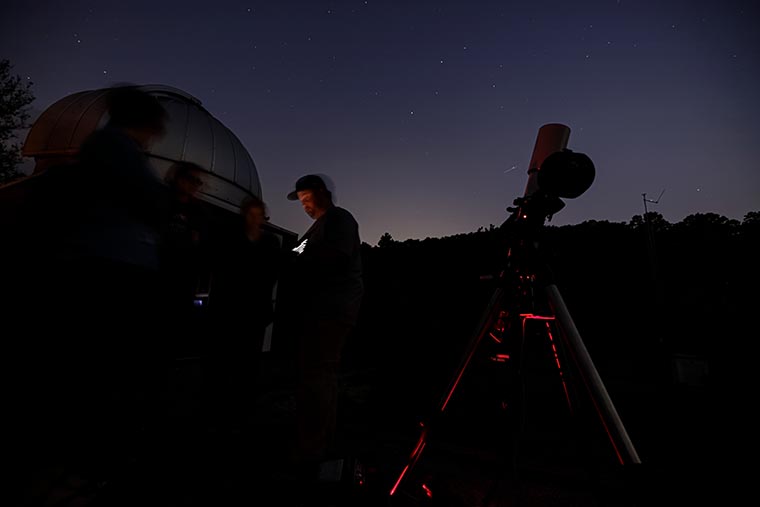
And Tyson is likely to stay that way. Buckley’s colleague Krawczynski, who often brings his own telescope when he volunteers at local amateur astronomy nights, notes that dark skies above other St. Louis area astronomy hotspots, like Broemmelsiek Park in St. Charles, are threatened by encroachment from housing and retail development.
“One of the main goals for Tyson is ecological preservation, but also another thing they have is preservation of the night sky,” Krawczynski said. “It should pretty much stay as it is right now in the future.”
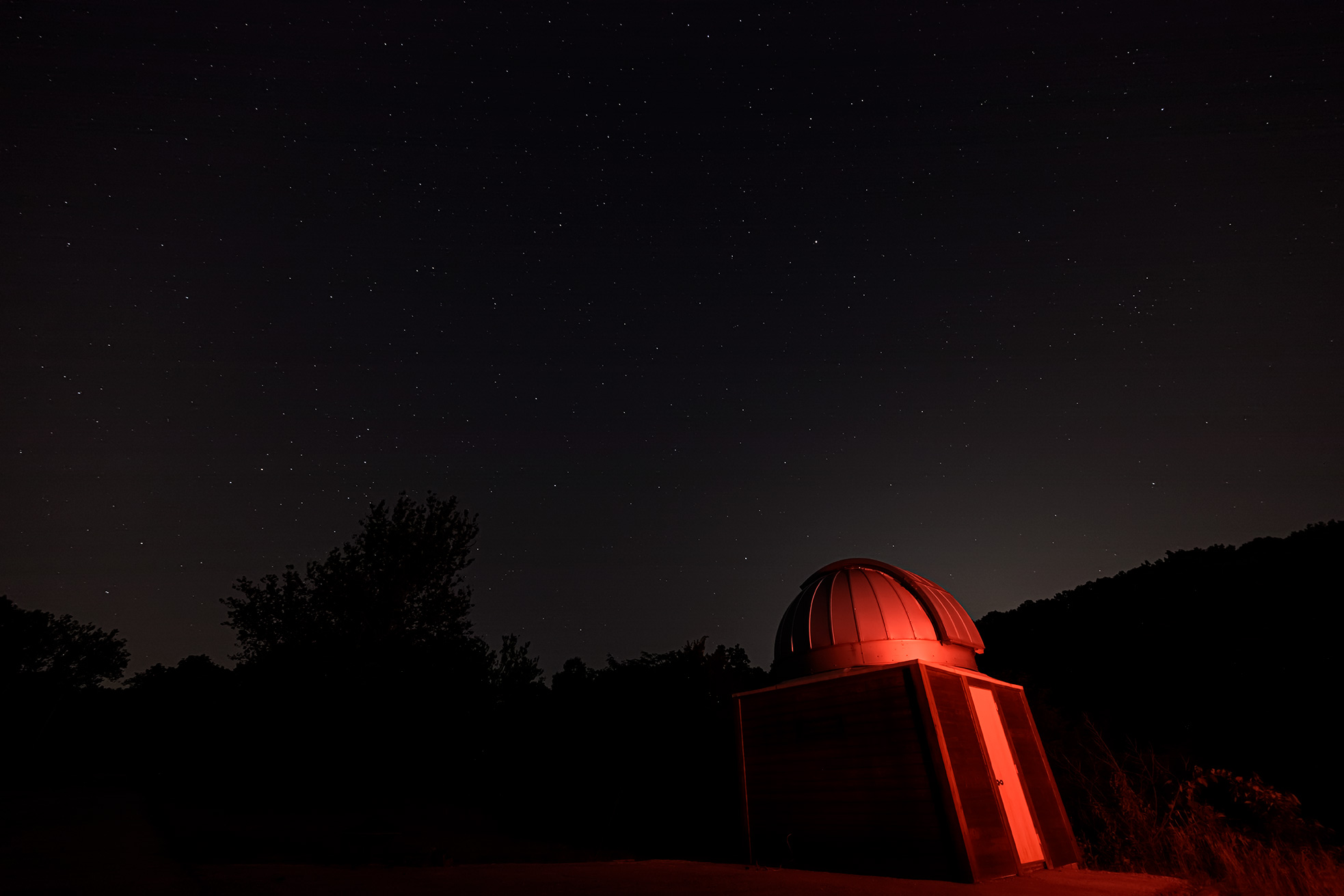
If you go:
The Tyson Observatory is located at Tyson Research Center, near Eureka, Mo. It is open for scheduled outreach events and by request. Contact Jim Buckley to arrange a visit.
The Crow Observatory is located on the Danforth Campus, on the roof of Crow Hall. It is open during the fall and spring semesters, 8-10 p.m. Monday-Thursday, weather permitting. Check the website or call the observatory at 314-935-6278 during viewing hours to see if the observatory is open. The observatory is open to the campus community and non-Washington University guests. For non-Washington University guests, prior arrangements must be made by contacting the Department of Physics office at 314-935-6276.
Students relax after learning about the night sky at the Tyson observatory.

